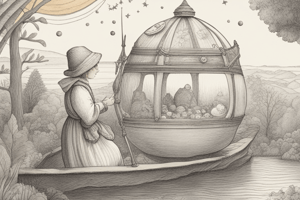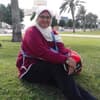Podcast
Questions and Answers
If a newly discovered celestial object orbits the Sun, is nearly round, but shares its orbital space with numerous other objects, how would it MOST likely be classified?
If a newly discovered celestial object orbits the Sun, is nearly round, but shares its orbital space with numerous other objects, how would it MOST likely be classified?
- A large asteroid, due to its shared orbital space.
- A moon, provided it orbits another planet within the solar system.
- A planet, as it meets two of the three criteria.
- A dwarf planet, as it hasn't cleared its orbit. (correct)
Which of the following BEST explains why comets develop tails as they approach the Sun?
Which of the following BEST explains why comets develop tails as they approach the Sun?
- The comet's internal nuclear reactions intensify.
- The Sun's gravity pulls material off the comet's surface.
- The solar wind vaporizes the comet's icy materials. (correct)
- The comet reflects more sunlight as it gets closer.
The phrase "My Very Excited Mother Just Served Us Nachos" is a mnemonic for remembering the order of planets. What aspect of planetary order does this mnemonic MOST accurately represent?
The phrase "My Very Excited Mother Just Served Us Nachos" is a mnemonic for remembering the order of planets. What aspect of planetary order does this mnemonic MOST accurately represent?
- Planetary size, from largest to smallest.
- Distance from the Sun, from closest to farthest. (correct)
- Planetary mass, from most massive to least massive.
- Orbital speed, from fastest to slowest.
What differentiates a natural satellite from an artificial satellite?
What differentiates a natural satellite from an artificial satellite?
Why do meteors typically emit light as they enter Earth's atmosphere?
Why do meteors typically emit light as they enter Earth's atmosphere?
Astronauts on the International Space Station (ISS) experience muscle loss. What is the PRIMARY reason for this phenomenon?
Astronauts on the International Space Station (ISS) experience muscle loss. What is the PRIMARY reason for this phenomenon?
Which of the following BEST describes the purpose of probes in space exploration?
Which of the following BEST describes the purpose of probes in space exploration?
What is the most significant reason why living on the International Space Station (ISS) presents environmental challenges for astronauts?
What is the most significant reason why living on the International Space Station (ISS) presents environmental challenges for astronauts?
The Kuiper Belt is a region beyond Neptune containing icy objects. What is another notable space feature located even farther from the Sun than the Kuiper Belt?
The Kuiper Belt is a region beyond Neptune containing icy objects. What is another notable space feature located even farther from the Sun than the Kuiper Belt?
If a planet is described as a 'terrestrial' planet, what is its MOST likely composition?
If a planet is described as a 'terrestrial' planet, what is its MOST likely composition?
Flashcards
The Sun
The Sun
The star at the center of our solar system, providing light and heat.
Main Asteroid Belt
Main Asteroid Belt
A region between Mars and Jupiter with a high concentration of asteroids.
Planet Criteria
Planet Criteria
A celestial body that orbits the Sun, is nearly round, and has cleared its orbit of other objects.
Moon
Moon
Signup and view all the flashcards
Planetary Order
Planetary Order
Signup and view all the flashcards
Asteroid
Asteroid
Signup and view all the flashcards
Comet
Comet
Signup and view all the flashcards
International Space Station (ISS)
International Space Station (ISS)
Signup and view all the flashcards
Alberta's First Satellite
Alberta's First Satellite
Signup and view all the flashcards
Probe
Probe
Signup and view all the flashcards
Study Notes
-
Our solar system is centered around the Sun.
-
The Main Asteroid Belt is located between Mars and Jupiter.
-
Pluto is classified as a dwarf planet.
-
A moon is a celestial body that orbits a planet.
-
Producing its own light is NOT a requirement to be considered a full-sized planet.
-
"My Very Excited Mother Just Served Us Nachos" is a mnemonic to remember the order of the planets in the solar system.
-
An asteroid is a small, rocky object that orbits the Sun, mostly found in the asteroid belt.
-
A comet is an icy celestial body that develops a glowing tail when it gets close to the Sun.
-
The International Space Station (ISS) is an artificial satellite that orbits Earth, allowing astronauts to conduct research.
-
Alberta's first satellite was called AlbertaSat-1.
-
The Sun is NOT a planet (False).
-
Not all celestial bodies emit their own light (False).
-
Satellites can be natural or artificial (False).
-
Probes are spacecraft that travel to distant celestial bodies without human passengers (True).
-
Living in space is NOT easy because there are environmental challenges (False).
-
A natural satellite is a celestial body that orbits a planet or other body, while an artificial satellite is human-made and launched into orbit.
-
Technologies used to explore space include telescopes, satellites, probes, and manned spacecraft.
-
Astronauts experience muscle loss in space due to the lack of gravity.
-
Societal barriers to space exploration include funding limitations, international cooperation challenges, and ethical concerns.
-
Meteors emit light when they enter Earth's atmosphere due to friction with the air, causing them to heat up and burn.
-
The largest planet in our solar system is Jupiter.
-
The four inner (terrestrial) planets of the solar system are Mercury, Venus, Earth, and Mars.
-
Pluto was reclassified as a dwarf planet because it has not cleared its orbit of other objects.
-
The Sun is a star.
-
One challenge astronauts face when living on the ISS is the lack of gravity, which can cause health problems.
Studying That Suits You
Use AI to generate personalized quizzes and flashcards to suit your learning preferences.





